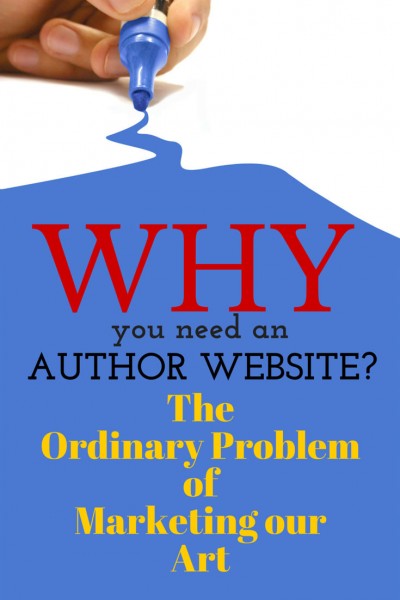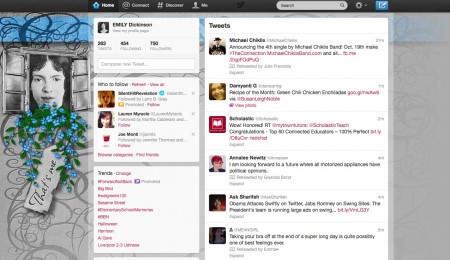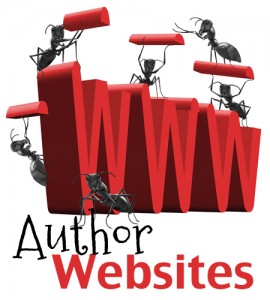This month-long series of blog posts will explain author websites and offer tips and writing strategies for an effective author website. It alternates between a day of technical information and a day of writing content. By the end of the month, you should have a basic author website up and functioning. The Table of Contents lists the topics, but individual posts will not go live until the date listed. The Author Website Resource Page offers links to tools, services, software and more.
But I Just Want to Write: The Ordinary Problem of Marketing our Art

I hear authors saying, “I just want to write.”
Wrong. You want to write and then have a lot of readers for your work. You just want those reader to find you automatically; you don’t want to work to get your writing in front of the reader. Or really, you want to work on your work, not on the work of getting readers.
David Bayles and Ted Orland, in their book, ART AND FEAR: OBSERVATIONS ON THE PERILS (AND REWARDS) OF ARTMAKING, touch on these issues in chapter which discusses the outside world: “Once the art has been made, an entirely new set of problems arise, problems that require the artist to engage the outside world.”
They call these ordinary problems, to emphasize that every artist/writer faces these problems and they are nothing new or different now than they were centuries ago.
“Among other things, they (ordinary problems with the outside world) consume the larger part of almost every artist’s time. One well-known painter, after several months of careful record keeping, reached the discouraging conclusion that even at best he could free up only six or seven days a month for actually painting, while the remaining twenty-odd days inevitably went to gallery business, studio clean-up, UPS runs and the like. Moral: There’s one hell of a lot more to art than just making it. In many cases, the art you make today will reach its audience tomorrow only because of a vast societal network geared to arts education, funding, criticism, publication, exhibition and performance.” (p. 65-66)
Sure, you can “just write” if you want. But then, no one will read what you wrote. How then do you connect to the outside world in such a way that you will find the legion of readers you want and your words deserves?
I Don’t Have Time for This
The biggest argument I hear against networking or marketing, especially doing it by using social media, is that it is a time drain.
In 1986, Richard B. Sewall talked about his biography of Emily Dickinson. He said she wrote “warm, loving, marvelous letters.” At the time, there were three published volumes of letters, but they represented “only about a tenth of what we know she wrote. She was a people person. Never mind that poem about selecting her own society and shutting the valves of her attention like a stone; her life revolved around people.” (Sewall, Richard B. The Life of Emily Dickinson. Harvard University Press, 1998.)
Other writers of the 18th and 19th century talk about spending an hour or two a day writing letters to keep those connections with people vibrant. Some devoted an entire half-day to correspondence, especially right after a book was published.
In her book, Charles and Emma (Henry Holt, 2009), Deborah Heligman says this about Charles Darwin’s correspondence after the publication of Origin of Species.
“Every day the postman brought bundles of letters to Down House—letter in reaction to the book. There were five hundred a year, every year, after The Origin of Species was published. Charles answered all of the—even the ones from quacks. He had lifelong correspondents, he had fans, he had critics, he had people who wrote asking to meet him, to give him gifts, to take his photograph. He took each letter seriously and gave it the time he felt it needed. During his lifetime he had two thousand correspondents. He wrote at least seven thousand letters and received as many. “ (Heligman, Deborah. Charles and Emma. New York, NY: Henry Holt, p. 195)

It’s likely that Emily Dickinson would have loved Tweets! Especially because she was an expert in short verse! 140 characters? A perfect medium for Emily! It’s likely that Charles Darwin would have maintained a blog.
Connecting with People Takes Time

In other words, people connections have always taken large amounts of time for writers. Why do we think it’s any different today? We write in our caves, and we want to live there. But in order for our writing to speak to today’s society, we must connect with others for many reasons: to think through ideas and discuss contemporary issues; to hook up with those who can put our work in front of others; to be bolstered by other writers, even as we encourage; to live in the midst of a literary community that is firmly nestled within the very fibers of our nation.
If the recluse poet’s life revolved around people, why do we balk so at social media? If a scientist can answer every single letter he received about a controversial book, why do we balk about putting up a website?
Today, social media enables a connected life, a life that revolves around people. The medium of letters has changed to blogs, tweets, Facebook posts, Pinterest boards and the latest social media platforms—but the reason we do these things hasn’t changed. Perhaps the medium also affects how shallow or deep those connections are, but that’s a different issue. Social media is social: people.
The question then becomes this: Do you want to connect with the people who will be reading your book?
The Nature of the Ordinary Problem
In a 2012 presentation, Jane Freidman, who worked for a decade at Writer’s Digest, updated this issue for today’s publishing climate by commenting:
“As Clay Shirky has said, it is no great or important thing to ‘publish’ something in a digital era. You can publish at the click of a button. The difficult work lies in getting attention in a world of cognitive surplus. Accordingly, more and more, respect tends to go toward those who earn the attention of readers, not those who pass muster with the gatekeepers.”
(Friedman, Jane. The Future of the Author-Publisher Relationship. September 28, 2012. LitFlow Magazine.
Again, Friedman:
“The biggest problem that authors must solve for themselves, year after year, is
(1) staying competitive, current and discoverable in a shifting digital landscape,
(2) having the right tools to be effective and in touch with their readers, and
(3) having a strong network of connections that helps them better market and promote.”
One of the biggest problem for today’s authors is Discoverability.
Discoverability demands that you have direct relationship with your audience. But how do you develop these relationships? What tools are best?
Word of Mouth—Still the Best Way to Sell
According to data from Bowker presented by the company’s vice president of publishing services Kelly Gallagher at the Digital Book World Discoverability and Marketing, there are now at least 44 different ways that people discover a book. And while publishers and marketers try to sift through the data and develop strategies, one thing remains constant:
“Amid all the change in how readers read and discover books, one thing has remained constant: in-person, personal recommendations are the No. 1 way people discover books, no matter who they are or how they read.”
(Greenfield, Jeremy. Book Discovery Landscape Becomes More Complicated as Reader Behavior Fractures. DigitalBookWorld.com. September 24, 2012.
In 2012, I recommended that a friend listened to the audio version of The Orphan Master’s Son by Adam Johnson (Random House, 2012). When it won the 2013 Pulitzer Prize, we were both thrilled; it was as if we had a personal stake in the book winning the award because we had read it before it won. Since the Prize, we’ve both recommended the book to several others—who are recommending it to their friends. It’s a slow process, yes. But it’s the most reliable process for spreading the word about a book.
The question is always, how can you get Word of Mouth (WOM) recommendations? So, how do you do that?
Earned, Owned and Paid
A useful concept from marketing people is the idea that there are three ways to reach people: earned, owned and paid media.
Earned Media is the traditional press release, earning the right to be heard by having something interesting to put in front of journalists. Today, this includes the wide world of social media. Owned media means things in your direct control. Today, this means your website and your profile on numerous online accounts. Paid media is the traditional advertising.
In the old days—twenty or twenty-five years ago—there was just earned and paid.
Advertising drove all marketing campaigns, you started and ended there.
Today—the Modern Marketing Campaign—starts with Earned Media, especially what you can Earn through social media.
Owned media, which is easily available, cheap and totally under your control, is where potential customers go to find information. What do you want your customers to know about you and your book(s)? That is what you should have on your website, your profile pages of various social media, and on any marketing information you hand out such as postcards. You should be the master of your the Owned Media; don’t leave this to the publishers, else they will own your audience exclusively. Beyond the Owned Media, publishers will be glad of anything you can do to help them Earn media attention. If there is any Paid media, publishers will take care that—with more dollars going to the high concept or high profile books of the season and less dollars to the midlisters, the newcomers and the rest.
Or, to say it a different way, we used to talk about these ways of promoting a book.
5 Options for Promoting Your Book
• Print: flyers and posters, ads in magazines/newspapers/specialized publications, sample chapters, direct marketing, newsletter, interviews, business cards, slogans/pitches
• Audio: radio or online interviews, read samples of your work, give reader’s reactions and comments
• Web: website and/or blog, email marketing, online ads, sample chapters, RSS, feeds, bulletin boards or forums, ezine or newsletter, affiliate programs, online contests, webinars, advertisements (from Craigslist to GoogleAds), ebooks, podcasts, vlogging, internet memes
• Personal appearances: BEA, ALA, local library, bookstore signings, literary festivals, teaching, school visits, speaking engagements, seminars, conferences, asking for referrals, elevator pitches, personal PR
• Social Media: Facebook, GoodReads, Twitter, LibraryThing, delicious.com, StumbleUpon.com; spending enough time to become part of the community; using announcements, contest, giveaways
If we re-categorize these for OWN media:
Owned media attracts customers: flyers, newsletter, interview, business card, slogan/pitch, podcasts, website and/or blog, email list, RSS, bulletin board followers, newsletter, affiliate programs, online contests, webinar, internet memes and the whole category of personal appearances
Earned media attracts fans: Interviews, comments/likes/shares, conversation online, GoodReads/LibraryThing/Amazon reviews, community endorsements
Paid media attracts strangers: posters, advertising in print or online, direct marketing, high profile interviews, high profile personal appearances, eligibility for some awards.
This series will talk about the basics of creating the most important part of your online presence, the Owned media or your web site. The best thing is that it is entirely within your control.
What Should be on an Author Website?
In 2008 Codex Group, a company that regularly studies characteristics of book audiences, surveyed about 21,000 people who buy books. Its objective was to “understand the relative effectiveness of author sites among shoppers and to determine the elements that will keep them coming back to the site.” The Codex study reported that 7.5% of readers visit an author website before they purchase a book.
“The Codex report found that visiting an author’s website is the leading way that book readers support and get to know their favorite authors better. And this is true regardless of age.”
Wow, don’t we want fans who will “want to get to know you better”? Of course.
What are these customers and fans looking for? According to the Codex report, these are things that will keep fans coming back.
- Exclusive, unpublished writing. 43% of survey respondents said they return regularly for exclusive content. This could include related short stories, but might also include a short essay on your cats. An interesting blog could do this, as well.
- Author Schedules. 36% want to know the author’s schedule of tours, book signings, and area appearances. In other words, is there any way that a fan could meet-up, get a signed book, watch you speak, etc.
- Author’s Literary Tastes. Readers want lists of the author’s favorite writers and recommended books. Younger fans are also more interested in knowing about their favorite authors’ book, music, and movie recommendations.
- Insider Information. 36% of readers (especially men) want “insider” tidbits. YOU know why you killed off that mother in chapter three; explain that to the readers on your website. Include things such as: Background info–where and how you did research; important inspirations for the story; your biggest struggles and biggest successes as you wrote this book.
- Freebies. 33% want downloadable extras like icons and sample chapters.
- Regular contact. 33% of readers want weekly e-mail news bulletins with updates on tours, reviews, and books in progress.
- Fans under the age of 35: contests, puzzles, and games, with prizes like autographed copies of books.
Let me re-emphasize the most important reason to create an author website and online social media accounts: YOU, the author, OWN these. Your publisher does not. If and when you move on to another publisher (or to Indie Publishing) you still own your audience.
From a publisher’s point of view, they want to own the audience, so they can sell more books. From the author’s point of view, you want to own your audience, so you can continue to write and have a career and sell more books. The publisher has an interest in your overall career, but not like you do. Only YOU are more passionate about your career than anyone else, certainly more passionate than an agent with dozens of other clients or a publisher with dozens of other authors.
You OWN this channel of information going out to readers. Why not take advantage of it? Where ELSE will reader find this information if not on your website?
Author Website Planning Checklist
Where on your website COULD you include these things? List all the appropriate page(s). If you listed more than one appropriate page, will you put the information on multiple pages or just on one page? Circle the page where you plan to include this information.
Exclusive unpublished writing: ______________________
Author Schedules: ________________________________
Author’s Literary Tastes:___________________________
Insider Information: _______________________________
Freebies: ________________________________________
Regular Contact: __________________________________
Contests, puzzles, teacher’s guides, book club discussion guides, puzzles, playlists, coloring pages, etc.__________________________________

Thank you for sharing your expertise! There’s so much here – and more even on your other posts. I like your idea about posting unpublished work. I never thought about doing that. I think it could be a brave move if I shared a short story on my website. My website contains mostly samples of my published (edited) magazine articles and links to a couple of blogs sites where I’ve posted content. I treat my website like a big, virtual business card. Thanks for giving me a needed push.
Heather:
You’re welcome! There’s more to come in this series, lots more!
Darcy
I’ll stay tuned! :)
Heather
Thank you for the great information including the owned/earned/paid media and the summary of the Codex report. I appreciate the time you spent putting the article together. This will be a good series to follow — and one to keep in mind for my own websites. Thank you!
KL: Thanks for the comment and for following the series.
How many “author websites” do you maintain?
Darcy